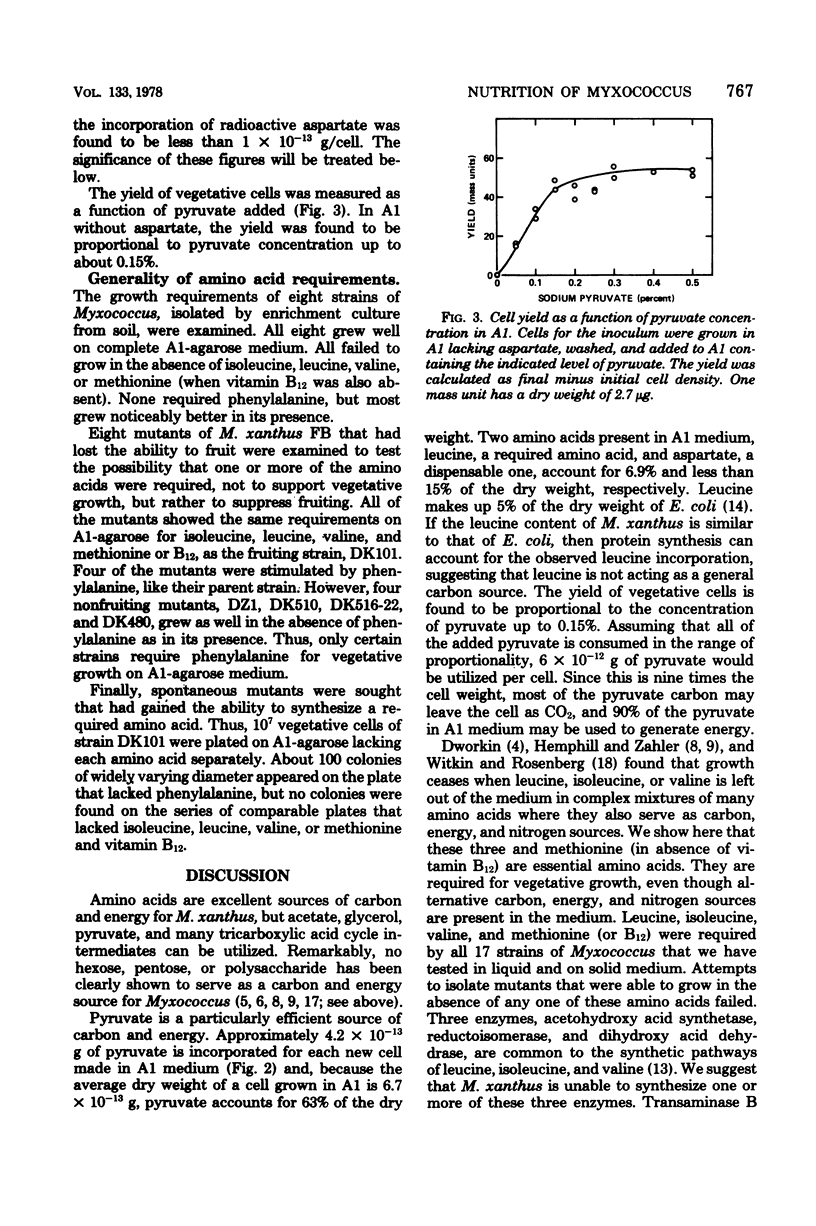Abstract
The minimal requirements for vegetative growth of Myxococcus xanthus have been sought. Isoleucine, leucine, and valine were required, and vitamin B12 was needed for the synthesis of methionine. Pyruvate was an excellent energy source and an efficient source of cellular carbon. Acetate, aspartate, glutamate, and most tricarboxylic acid cycle intermediates could also be utilized, but were less efficient sources of carbon and energy than was pyruvate. Many mono- and disaccharides were tested, but, in agreement with earlier results, none served as carbon-energy sources. A minimal medium (A1) has been devised that includes the essential amino acids and vitamin B12, with pyruvate and aspartate as carbon-energy sources. In this medium, M. xanthus could propagate indefinitely, and on it vegetative cells formed colonies with greater than 75% efficiency; hence, it is likely that no organic cofactors other than those present in A1 are required in more than trace amounts.
Full text
PDF





Selected References
These references are in PubMed. This may not be the complete list of references from this article.
- Burchard R. P., Dworkin M. Light-induced lysis and carotenogenesis in Myxococcus xanthus. J Bacteriol. 1966 Feb;91(2):535–545. doi: 10.1128/jb.91.2.535-545.1966. [DOI] [PMC free article] [PubMed] [Google Scholar]
- Burchard R. P. Gliding motility mutants of Myxococcus xanthus. J Bacteriol. 1970 Nov;104(2):940–947. doi: 10.1128/jb.104.2.940-947.1970. [DOI] [PMC free article] [PubMed] [Google Scholar]
- Burchard R. P. Growth of surface colonies of the gliding bacterium Myxococcus xanthus. Arch Microbiol. 1974 Mar 7;96(3):247–254. doi: 10.1007/BF00590180. [DOI] [PubMed] [Google Scholar]
- DWORKIN M. NUTRITIONAL REGU.ATION OF MORPHOGENESIS IN MYXOCOCCUS XANTHUS. J Bacteriol. 1963 Jul;86:67–72. doi: 10.1128/jb.86.1.67-72.1963. [DOI] [PMC free article] [PubMed] [Google Scholar]
- DWORKIN M. Nutritional requirements for vegetative growth of Myxococcus xanthus. J Bacteriol. 1962 Aug;84:250–257. doi: 10.1128/jb.84.2.250-257.1962. [DOI] [PMC free article] [PubMed] [Google Scholar]
- Dworkin M. Biology of the myxobacteria. Annu Rev Microbiol. 1966;20:75–106. doi: 10.1146/annurev.mi.20.100166.000451. [DOI] [PubMed] [Google Scholar]
- Hemphill H. E., Zahler S. A. Nutrition of Myxococcus xanthus FBa and some of its auxotrophic mutants. J Bacteriol. 1968 Mar;95(3):1011–1017. doi: 10.1128/jb.95.3.1011-1017.1968. [DOI] [PMC free article] [PubMed] [Google Scholar]
- Hemphill H. E., Zahler S. A. Nutritional induction and suppression of fruiting in Myxococcus xanthus FBa. J Bacteriol. 1968 Mar;95(3):1018–1023. doi: 10.1128/jb.95.3.1018-1023.1968. [DOI] [PMC free article] [PubMed] [Google Scholar]
- LEADBETTER E. R. CONTROL OF GROWTH AND MORPHOGENESIS IN SOME MYXOCOCCUS SPECIES. Nature. 1963 Dec 14;200:1127–1128. doi: 10.1038/2001127a0. [DOI] [PubMed] [Google Scholar]
- MCCURDY H. D., Jr GROWTH AND FRUITING BODY FORMATION OF CHONDROMYCES CROCATUS IN PURE CULTURE. Can J Microbiol. 1964 Dec;10:935–936. doi: 10.1139/m64-126. [DOI] [PubMed] [Google Scholar]
- RAMAKRISHNAN T., ADELBERG E. A. REGULATORY MECHANISMS IN THE BIOSYNTHESIS OF ISOLEUCINE AND VALINE. II. IDENTIFICATION OF TWO OPERATOR GENES. J Bacteriol. 1965 Mar;89:654–660. doi: 10.1128/jb.89.3.654-660.1965. [DOI] [PMC free article] [PubMed] [Google Scholar]
- Sudo S., Dworkin M. Bacteriolytic enzymes produced by Myxococcus xanthus. J Bacteriol. 1972 Apr;110(1):236–245. doi: 10.1128/jb.110.1.236-245.1972. [DOI] [PMC free article] [PubMed] [Google Scholar]
- Witkin S. S., Rosenberg E. Induction of morphogenesis by methionine starvation in Myxococcus xanthus: polyamine control. J Bacteriol. 1970 Sep;103(3):641–649. doi: 10.1128/jb.103.3.641-649.1970. [DOI] [PMC free article] [PubMed] [Google Scholar]


